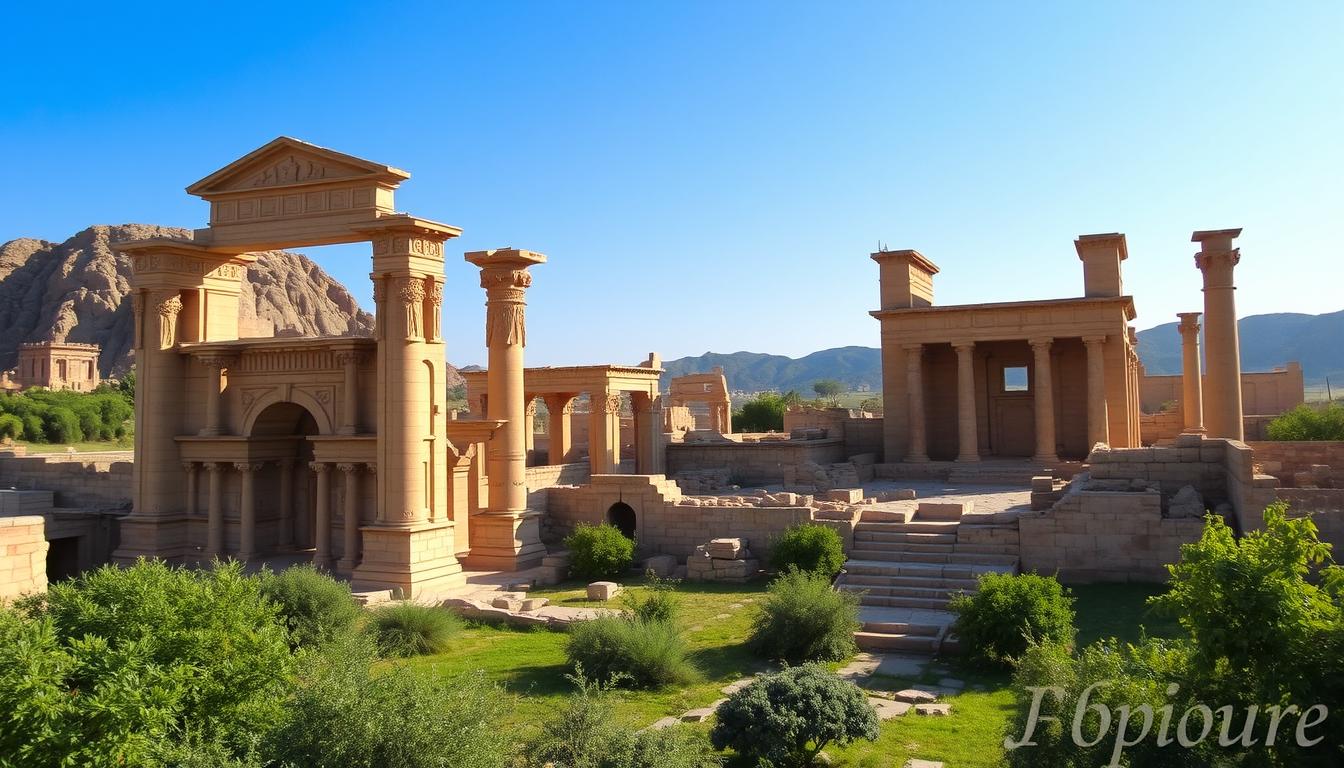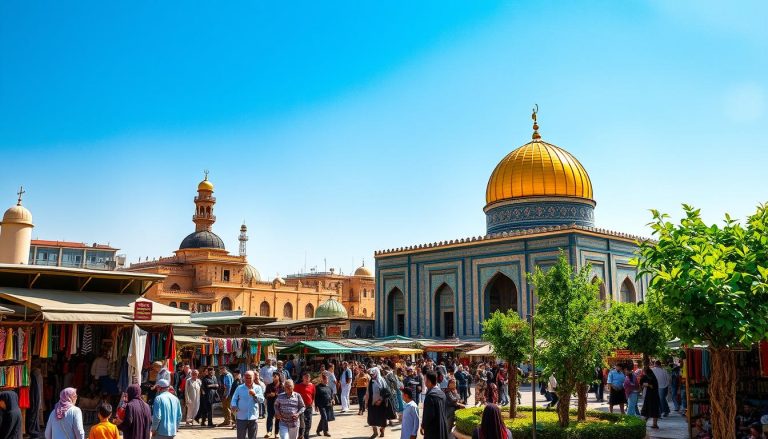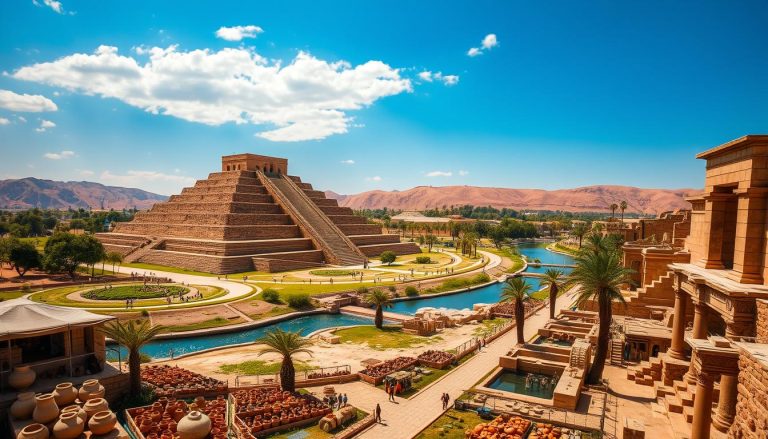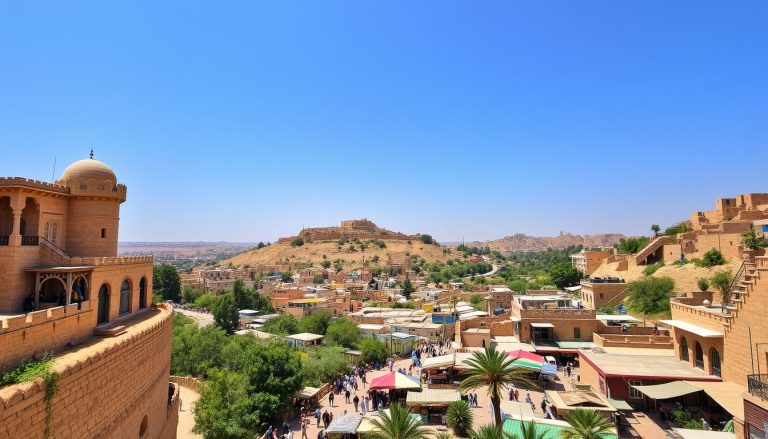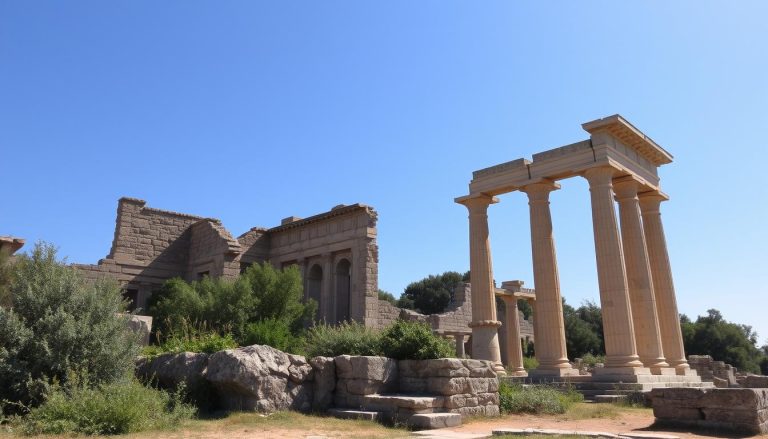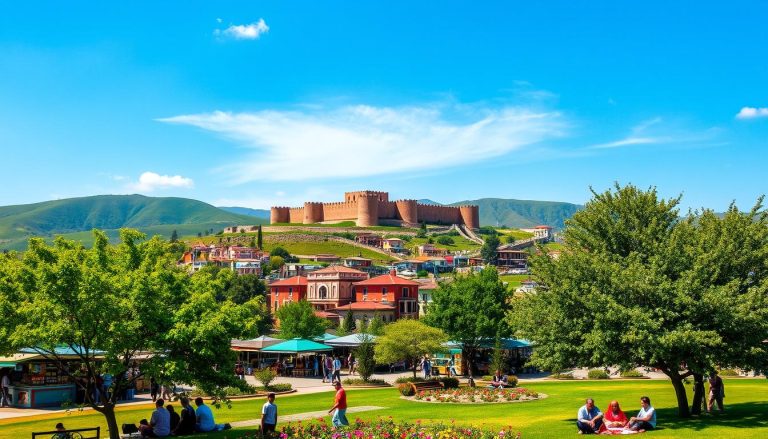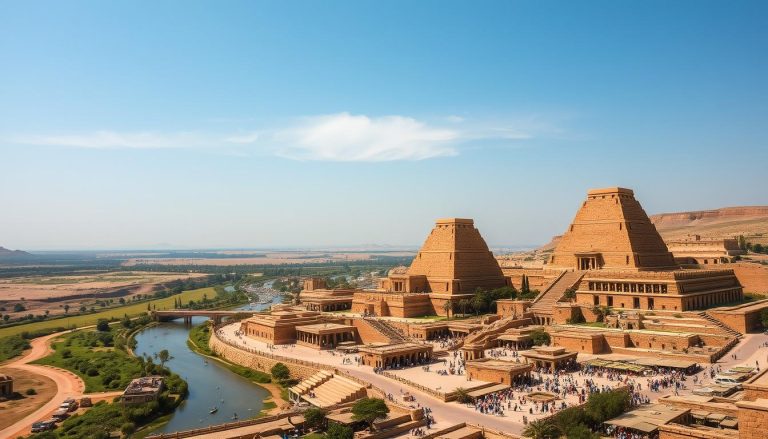Have you ever heard of Hatra, Iraq? This ancient city was once a major religious center. It was known as “Beit Elaha” or the “House of God.” It thrived during the Parthian Empire’s rule from the 1st to 3rd centuries AD.
Hatra is now a UNESCO World Heritage Site. Its ruins and statues give us a peek into Iraq’s ancient past. But what makes this city so unique, and why should you visit?
Key Takeaways
- Hatra was an important religious center in the Parthian Empire from the 1st to 3rd centuries AD
- The site is a UNESCO World Heritage Site, featuring impressive ruins and statues
- Hatra has faced threats, including recent damage by ISIS, but remains a significant archaeological treasure
- Visiting Hatra offers a unique opportunity to explore Iraq’s ancient history and culture
- The site is accessible and can be incorporated into a broader tour of Iraq’s historical landmarks
Introduction to Ancient Hatra: The Historic Gem of Iraq
Hatra is a key part of Iraqi history, known for its stunning Parthian architecture. It dates back to the 1st century AD. This ancient city is a UNESCO World Heritage site, attracting visitors with its rich culture.
Historical Significance and UNESCO Status
Hatra thrived during the Parthian Empire, starting in the 3rd century BC. It stood strong against Roman emperors Trajan and Septimius Severus. Its fall to Persian king Shapur I in 240 AD didn’t erase its legacy. In 2015, it was named a UNESCO World Heritage Site, celebrating its cultural and historical value.
Geographic Location and Access
Hatra is about 290 kilometers northwest of Baghdad, in Iraq’s Ninawa Governorate. Getting there requires careful planning and local permits for a safe visit.
Best Time to Visit
The best time to see Hatra is in spring and fall. The weather is mild, making your visit more enjoyable. Summer’s heat is best avoided for a better experience.
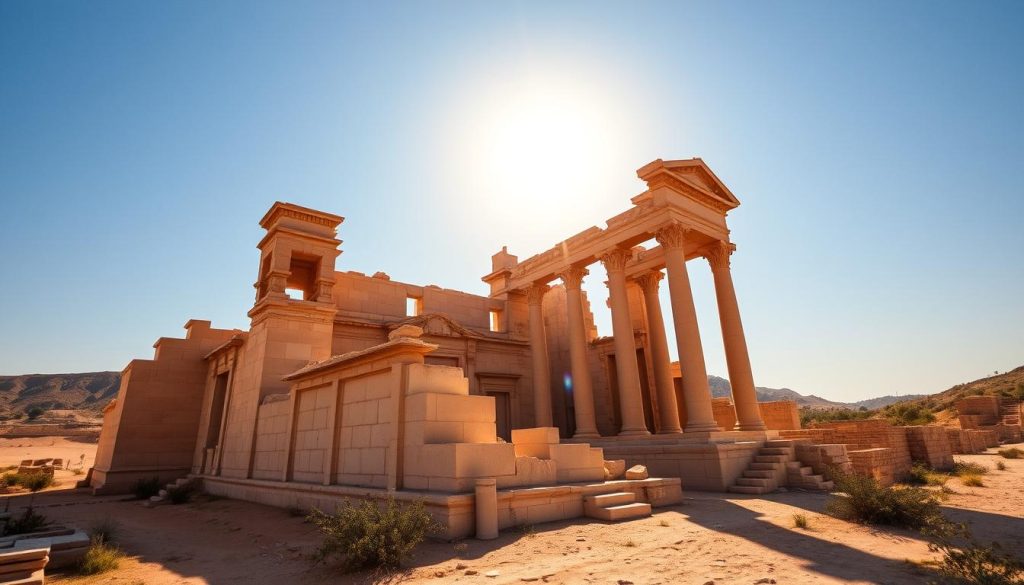
| Key Fact | Value |
|---|---|
| ISBN | 978-1-4632-4547-4 |
| ISSN | 2690-2222 |
| Total Number of Figures | 90 |
| Total Number of Maps | 2 |
| Total Number of Plans | 20 |
| Members on the Series Editorial Board | 30 |
| Members on the Advisory Editorial Board | 15 |
Hatra’s architecture and history make it a must-see for history buffs. Its UNESCO status and location offer a deep dive into the region’s culture.
Getting to Hatra: Transportation and Entry Requirements
Planning a trip to Hatra in Iraq needs some thought. You’ll need to get travel permits from Baghdad first. To get there, you can take shared taxis or drive from cities like Mosul or Tikrit. But, be ready for many checkpoints on your way.
Getting into Hatra can take some time. You’ll have to go through passport scans and security checks. To make things easier, think about getting a local guide or joining a tour. They can help with the paperwork and get you through the checkpoints faster.
In 2022, if you’re vaccinated against COVID-19, you won’t need a PCR test to visit Iraq. You can get a visa on arrival for a fee of $75 to $80. This applies to citizens of the US, Canada, UK, Australia, and EU countries.
The cost to get from the airport to Baghdad is between 35,000-45,000 IQD ($23-$30) per vehicle. Or, you can take an airport shuttle to Abbas Ibn Firnas Square for 8,000 IQD ($5) during the day. To enter Iraq, including Iraqi Kurdistan, you must get your visa in Baghdad. Otherwise, your visa will only be for Iraqi Kurdistan.
| Requirement | Details |
|---|---|
| Travel Permits | Visitors need permits from Baghdad authorities to access Hatra. |
| Transportation | Shared taxis or private vehicles from nearby cities, with multiple checkpoints along the way. |
| Entry Procedures | Time-consuming, involving passport scans and security checks. Local guides or tour operators can facilitate the process. |
| Visa on Arrival | Available for citizens of various countries, costing between $75 and $80. |
By planning ahead and knowing what you need, your trip to Hatra in Iraq will be smooth and fun.
The Great Temple Complex: Architecture and Religious Significance
At the heart of the ancient city of Hatra lies the impressive Parthian architecture of the Great Temple Complex. This architectural marvel showcases the rich cultural and religious heritage of the region. It blends Hellenistic and Oriental influences to create a unique and captivating structure.
Temple of Shamash
The centerpiece of the complex is the Temple of Shamash, dedicated to the sun god. This grand structure features towering iwans (vaulted halls) and intricate stone carvings. These carvings depict various deities and religious scenes. The attention to detail and the seamless integration of different architectural styles are a testament to the engineering prowess of the ancient builders.
Temple of the Triad
Another significant component of the Great Temple Complex is the Temple of the Triad, a religious structure that honors a trio of deities. The temple’s design showcases the region’s rich religious structures and the importance of the sun god in the local ancient engineering.
Notable Architectural Features
- Towering iwans (vaulted halls) that create a sense of grandeur and scale
- Intricate stone carvings adorning the walls, depicting religious figures and scenes
- A blend of Hellenistic and Oriental architectural styles, reflecting the cultural diversity of the region
- Impressive masonry techniques and engineering feats that have stood the test of time
The Great Temple Complex of Hatra is a true testament to the architectural and engineering prowess of the Parthian civilization. Its remarkable religious structures and sun god iconography offer a glimpse into the region’s rich cultural and spiritual heritage.
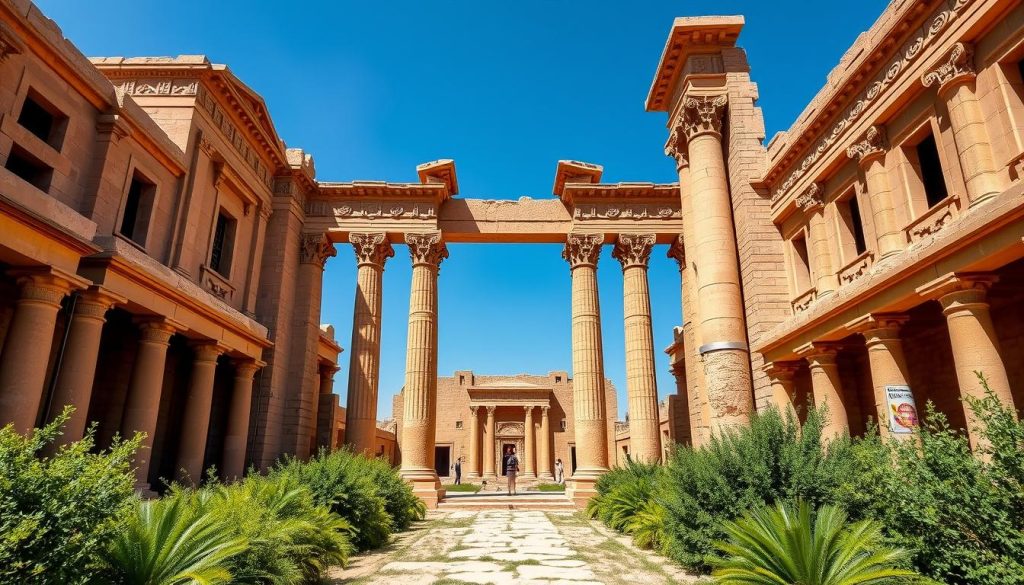
“The Great Temple Complex of Hatra is a masterpiece of ancient engineering, seamlessly blending Hellenistic and Oriental influences to create a truly awe-inspiring architectural marvel.”
Archaeological Treasures and Ancient Artifacts
Hatra, an ancient city in northern Iraq, is a treasure trove of archaeological wonders. It’s a UNESCO World Heritage Site, filled with Parthian-era sculptures, inscriptions, and artifacts. These pieces give us a glimpse into the region’s rich past.
The limestone statues of King Sanatruq I, the first king of Hatra, are housed in the Erbil Civilization Museum. These statues, along with other excavated items, offer insights into the Parthian Empire’s culture and religion. They date back to the city’s heyday between the 1st and 3rd centuries AD.
Unfortunately, Hatra has suffered damage in recent years. Religious extremists, like ISIS, have destroyed many ancient sculptures and inscriptions. They used picks, sledgehammers, and even assault rifles to vandalize these priceless treasures.
Despite this, restoration efforts are underway to preserve the remaining artifacts and structures at Hatra. Governments and institutions are supporting these efforts. They aim to restore the Parthian sculptures, inscriptions, and other archaeological excavations for future generations.
“Hatra, with its unique blend of Greco-Roman and Persian architectural styles, stands as a testament to the region’s vibrant cultural heritage. The loss of these museum pieces is truly a tragedy, but the determination to restore and protect this site is a beacon of hope for preserving Iraq’s invaluable archaeological legacy.”
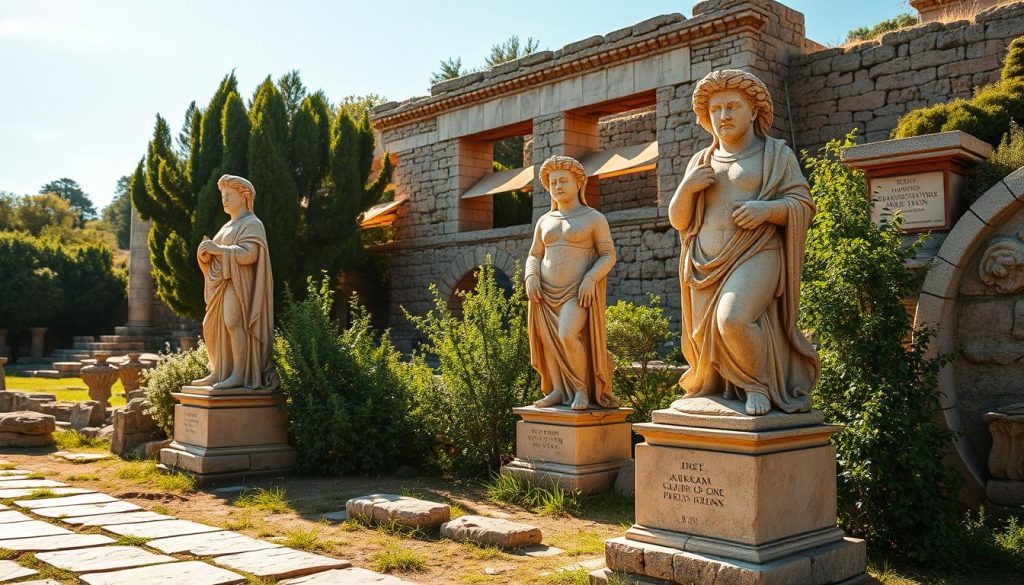
Visitors to Hatra are struck by its grandeur and significance. The ongoing efforts to safeguard its treasures show the importance of preserving the past. They ensure that the world can continue to learn from and appreciate Iraq’s cultural heritage.
Hatra, Iraq: Best Things to Do - Top Picks
Hatra, an ancient city in northern Iraq, is a treasure trove of history and beauty. Visitors can explore the famous city walls and find amazing photo spots. It’s a place that promises unforgettable adventures.
Exploring the City Walls
Walking the ancient city walls of Hatra is a must. These walls, built in the 1st century AD, offer stunning views. As you walk, you’ll feel like you’ve stepped back in time, imagining the city’s past.
Photography Spots
Hatra is a paradise for photographers. The Great Temple is a standout, with its detailed architecture and tall columns. The ruins also have many statues and carvings, perfect for capturing the past’s beauty.
While most of Hatra is open for photos, some areas inside the temple may not be. Always check with local guides or authorities to respect the site’s culture and traditions.
Guided Tour Options
For a deeper dive into Hatra’s history, consider a guided tour. These tours, led by experts, offer insights and access to restricted areas. You’ll learn more about the site’s ancient defenses and have a chance to ask questions.
Hatra offers a unique blend of history and beauty. Whether you love history, photography, or just want to experience a real cultural gem, Hatra will impress you.
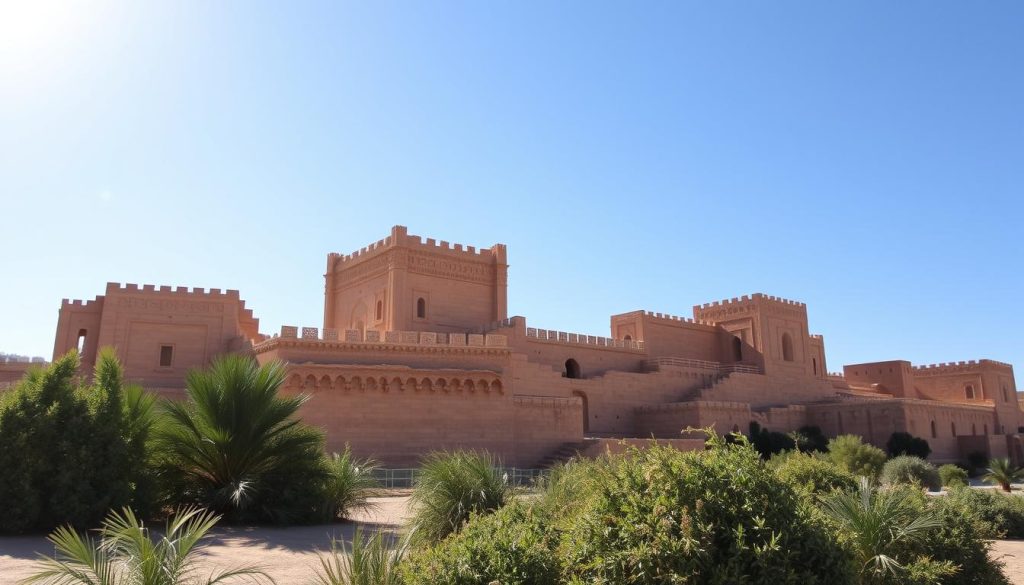
Safety and Travel Considerations
Traveling to Hatra in Iraq is safer now, but it’s still important to be careful. Always check the latest travel advisories before you go. You’ll see military around, so it’s wise to have local guides or escorts with you.
When you visit Hatra, don’t expect fancy facilities. Bring lots of water and sun protection because the desert is very hot. Good planning and packing will make your trip safe and enjoyable.
- Check the latest travel advisories for Iraq and the Hatra region
- Expect a visible military presence at the archaeological site
- Consider hiring a local guide or escort for navigation and communication
- Pack water, sun protection, and other essentials for your visit
By staying informed and taking the right steps, you can safely see the ancient wonders of Hatra. With the right preparation, you’ll dive deep into the history and culture of this amazing Iraqi place.
“Despite the situation calming down, there is still a level of underlying risk in the region.”
– A US Marine stationed in the area
Local Culture and Etiquette
When you visit Hatra in Iraq, remember to respect the local culture and customs. Wearing conservative dress and being sensitive to cultural norms will help you have a good time with the friendly Iraqi people.
Dress Code
Iraqi culture values modesty, especially at religious sites. To show respect, wear conservative dress that covers your shoulders and knees. Don’t wear anything too casual or revealing, as it might be seen as disrespectful.
Cultural Sensitivities
When you’re in Hatra, be careful with cultural respect. There might be rules about taking pictures, so always ask before snapping photos of people or sensitive spots. Also, avoid gestures or actions that could be seen as offensive in this area.
Interaction with Locals
The people of Hatra and nearby areas are very welcoming. Talking to locals and learning some Arabic phrases can make your trip better. Approach them with an open and respectful attitude.
“The people of Iraq are some of the most welcoming and hospitable in the world. By embracing their cultural traditions, you’ll create lasting memories of your visit to Hatra.”
Accommodation and Dining Options Near Hatra
Visiting Hatra in northern Iraq means you’ll find few places to stay and eat nearby. Most people stay in cities like Mosul or Baghdad. These places have more nearby hotels and things to do.
At Hatra, there’s not much to eat or drink. But, you can try Iraqi cuisine in nearby towns. Many guided tours include meals with local families. This gives you a real taste of Iraqi hospitality and culture.
For easier travel, some hotels and tour operators in Mosul or Baghdad can help. They can arrange day trips to Hatra. This makes your visit smoother and more enjoyable.
Even though there’s not much to stay near Hatra, the bigger cities offer great places to stay. You can also dive into the local food and culture. This makes your trip to this historic area of Iraq unforgettable.
| Accommodation Options | Dining Experiences |
|---|---|
|
|
Conclusion
Hatra’s importance as an ancient Mesopotamian city is clear. Despite its struggles, efforts to save this UNESCO World Heritage site show Iraq’s dedication to its culture. By visiting Hatra, you can dive into Iraq’s rich history and understand its people’s strength.
As Iraq grows its tourism, seeing Hatra helps the country’s economy and culture. New hotels and tours around the site offer unique experiences. They let you see the ancient ruins and help the local community.
Hatra’s stunning buildings, religious importance, and artifacts show the ancient Mesopotamians’ achievements. Saving this site not only protects Iraq’s heritage but also lets the world see its enduring spirit. This spirit has shaped Iraq’s past and will continue to influence its future.
